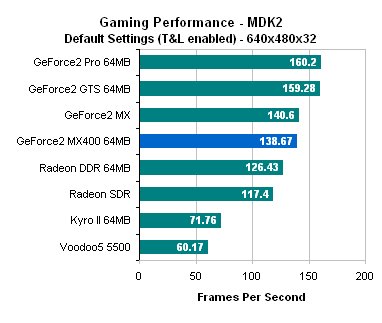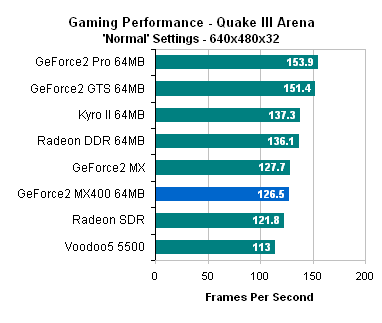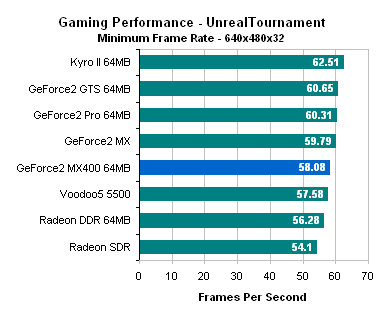JF_Aidan_Pryde
Regular
If that Silent Hill 3 shot is real time, I am speechless.
Well, as I mentioned, 60hz is bothersome to me even with static image - the refresh itself is too low. As for tearing, I don't doubt it wouldn't bother me in multiplayer FPS games, but then the visuals are secondary in those - I actually preferred playing Q2 in software mode, no matter how bad it looked, simply because the blander lighting made everything easier to seeOnce in a while I notice it. Most people game with the refresh @60Hz where it is a rather serious issue(pervasive). Up the refresh rate high enough and it is significantly reduced.
Actually overdraw with volumes can get a whole lot higher then that, but that's besides the point.How much fill would you need? Running 640x480 with 4x OD you have enough fill for six passes on a GF1 at 60FPS, twelve @30.
Well, as I mentioned, 60hz is bothersome to me even with static image - the refresh itself is too low.
I actually preferred playing Q2 in software mode, no matter how bad it looked, simply because the blander lighting made everything easier to see
Things just don't work as simple as calculating OD and available fill like that. But that has been debated before on this forum, so let's not go over it again.
Just a note though - with the ratio of average volume triangle size vs its vertex calculation overhead, increasing fillrate would result in faster rendering speed going well over 3gpix (at 640x480 that is).
At any rate, GF1's better balance might mean it would be closer to stock GF2 performance, but the baseline performance we're looking at is still rather low, relatively speaking.
Sorry, but i just don't believe this.
Again, i have a GF2MX( = GF1) and even at 640x480 + low details, current games either do not run at stable framerates and or they certainly do not look better than many PS2 games.
I have tried running games/demos of NWN, RSC, Fifa, RtCW, AmericaArmy, Battlefield1942, AvP2, NOFL2, RF on my setup.




Probably, but I guess it was sort of a 'used to' thing. I had most of my play time with Q2 early on when still using RagePro that couldn't handle hw accelerated version at all.You know, you could just kill the lightmaps and still run in hardware mode, game runs a hell of a lot faster that way
Might be, but as you said yourself, PC titles aren't using graphics hardware very effectively.IIRC from that conversation noone came up with a fill limited title @ console res though.
I was referring only to pixel volume fill, no other operation. The untextured, single color value triangles that only update stencil count - the same for any current rasterizer - higher texel rate won't do you any good here.Over 3Gpix for what type of rasterizer?
Yes, and I also stated that I believe GF1 would probably have a performance edge on DOT3 and stuff, but that would be greatly offset by other factors.How many passes would it take to pull off cube maps on the GS? You've stated that you could pull off Dot3 in two passes on the GS, factoring that and the fact that you must apply textures, aren't you cutting your MPixel fill down to less then 100MPixel edge over the GeForce1(ignoring cube maps)?

I was referring only to pixel volume fill, no other operation. The untextured, single color value triangles that only update stencil count - the same for any current rasterizer - higher texel rate won't do you any good here.
GS can actually draw these at max 2.4gpix, but as I said, faster fill would still make a difference.
Curious, do you know the shape of pixel footprint in MS mode, is it still a square?
OK, you don't believe it-
Probably, but I guess it was sort of a 'used to' thing. I had most of my play time with Q2 early on when still using RagePro that couldn't handle hw accelerated version at all.
After I upgraded the graphics, I sort of couldn't get used to accelerated look too well (it actually hurt my play - online).
You're pretty much left with basic reflection uses and stuff, which I'd say are a rather small part of total rendering.
In OpenGL there are 3 passes used for applying a cubemap, I think it could be done in 2 for our case.
What the hell?? When I had GF2MX (the original one, purchased before they made 200 and 400) with 633MHz Celeron, I could barely get MDK2 running at stable 40-50FPS in that resolution with everything at maximum.
Not to mention how simplistic MGS2 looks tech-wise compared to best looking games on PS2.
Which brings me to why this GF1 > PS2 using certain PC/Console games is nonsense.
Since they are different hardware working in different environments. There are just too many factors to consider for a fair comparison.
Those benchmarks are good at comparing rigs, but sadly, it doesn't reflect the performance when you are playing the actual game.
MaxPayne also plays faster on the GF2MX then the PS2, as does UnrealTournament. I tried finding scores for all the games that were on both platforms, hell the GF2MX even posts higher scores then the XBox does in the games that are on both platforms. The NV1X chips have quite a bit more power then what most people seem to give them credit for, the XBox's power really hasn't been pushed yet.
NWN on the other hand was fine for me (retail). I tend to run everything at 640x480 anyways (free AA from LCD scale-down )
The NV1X chips have quite a bit more power then what most people seem to give them credit for, the XBox's power really hasn't been pushed yet.
You can turn the framerate counter on in some of those games, and as long as you have VSync disabled they are fairly accurate. One of the benches I posted was minimum framerate, not average.

Id Software's John Carmack stated in his 9/2 .plan update that Quake 3 targets about 10,000 triangles per frame.
Real life perfomace that I've experienced, aside, that makes me even more suspicious about those benchmarks :\hell the GF2MX even posts higher scores then the XBox does in the games that are on both platforms
